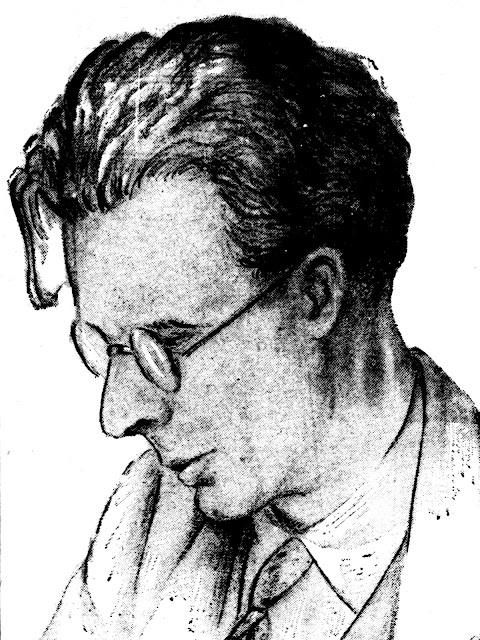
Aldous Huxley
Author of “Eyeless in Gaza”
from a drawing by S. Holt McAloney.
This drawing of Aldous Leonard Huxley by S. Holt McAloney appeared in the Washington Evening Star on July 11, 1936.
Huxley, Aldous Leonard (1894–1963), English novelist, essayist, critic, and poet, grandson of Thomas and brother of Julian, born in Godalming, Surrey, and educated at Eton College and the University of Oxford. He worked on various periodicals and published four books of verse before the appearance of his first novel, Crome Yellow (1921). The novels Antic Hay (1923) and Point Counter Point (1928), both of which illustrate the nihilistic temper of the 1920s, and Brave New World (1932), an ironic vision of a future utopia, established Huxley’s fame. During the 1920s he lived largely in Italy and France. He immigrated to the U.S. in 1937. Among his more than 45 books are the volumes of essays Jesting Pilate (1926), Ends and Means (1937), Tomorrow and Tomorrow and Tomorrow (1956), Brave New World Revisited (1958), and Literature and Science (1963). Other novels include Eyeless in Gaza (1936), After Many a Summer Dies the Swan (1939), Ape and Essence (1948), and Island (1962). Huxley also wrote on science, philosophy, and social criticism. Important nonfiction works include The Art of Seeing (1932), The Perennial Philosophy (1946), and The Devils of Loudon (1952). The Doors of Perception (1954) and its sequel Heaven and Hell (1956) deal with Huxley’s experiences with hallucinogenic drugs.
Britain's National Gallery of Art has an autographed cigarette card of Huxley as well as the Howard Coster photo after which it was fashioned.
Will's Cigarettes
1937
Aldous Huxley
by Howard Coster
1934
The caricature below accompanied a Libravox recording of The Defeat of Youth and Other Poems. It gives Huxley a similar treatment emphasizing his youth and his thick glasses.
This 1948 from The Evening Star shows a more mature Huxley without his glasses.
This dramatic 1956 photo by Sanford Roth also omits the glasses. It was published in the Evening Star with the caption, “The pills Novelist Huxley foresaw are here now.”






No comments:
Post a Comment